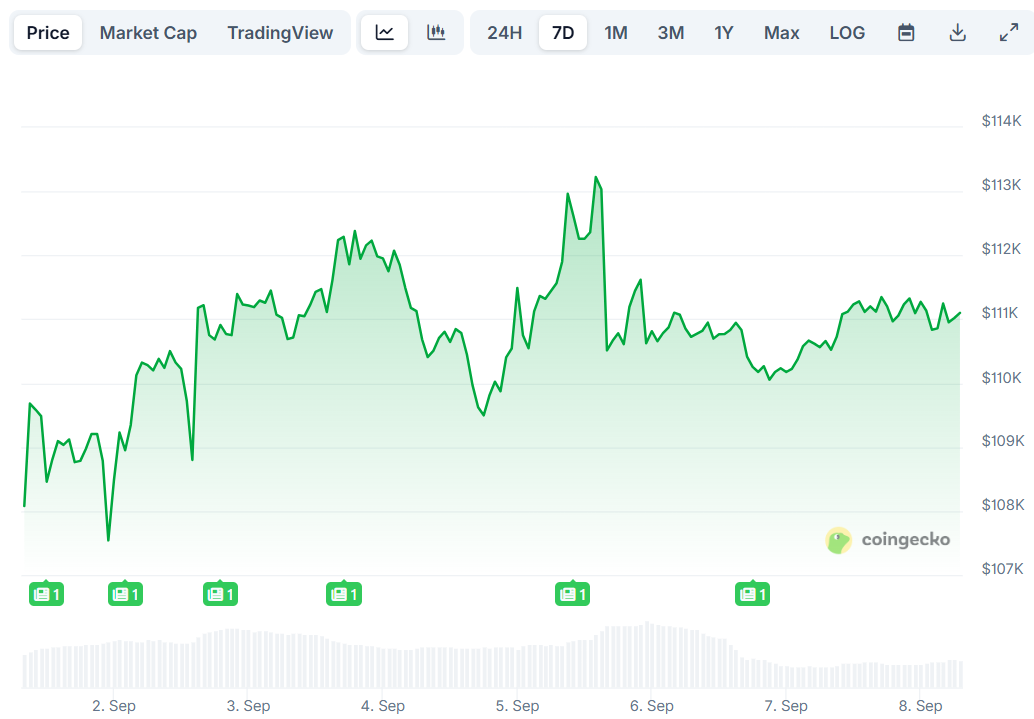TLDR
- Bitcoin whales sold 112,000-115,000 BTC worth approximately $12.7 billion in the past month, marking the largest sell-off since mid-2022
- The selling pressure pushed Bitcoin prices below $108,000 and contributed to a 6.5% decline in August
- Whale reserves dropped to their lowest levels since 2022, with the most aggressive selling occurring in early September
- Recent selling has slowed from 95,000 BTC weekly to around 38,000 BTC as of September 6
- Bitcoin is currently trading in a range between $110,000-$111,000 as institutional buying provides some counterbalance to whale selling
Bitcoin faced intense selling pressure last month as large holders dumped over 112,000 coins worth approximately $12.7 billion. This represents the biggest whale distribution since July 2022.
The selling came from whales holding between 1,000 and 10,000 BTC. These major players reduced their holdings after accumulating roughly 270,000 BTC between April and August.
Bitcoin’s price dropped 6.5% in August, ending a four-month winning streak. The cryptocurrency fell from its $115,778 opening price as smart money took profits.
CryptoQuant data shows whale reserves decreased by more than 100,000 Bitcoin over 30 days. This signals what analysts call “intense risk aversion among large investors.”
The seven-day balance change peaked on September 3 with over 95,000 BTC moved by whales. This marked the highest weekly movement since March 2021.
Selling Pressure Shows Signs of Slowing
Recent data suggests the aggressive selling may be cooling off. Weekly balance changes dropped to around 38,000 BTC as of September 6.

Bitcoin has traded in a tight range between $110,000 and $111,000 over the past three days. The narrower trading range reflects reduced selling pressure.
Whale activity pushed Bitcoin below $108,000 during the heaviest selling period. The cryptocurrency struggled to maintain support levels as large holders continued dumping coins.
Bitcoin entrepreneur David Bailey previously suggested prices could reach $150,000 if two key whales stopped selling. His comments highlight how concentrated the selling pressure has been.
Institutional Buying Provides Counterbalance
Despite whale selling, institutional accumulation has provided some market stability. Corporate buyers and ETF demand helped absorb some of the selling pressure.
LVRG Research director Nick Ruck notes this creates a “structural counterbalance” to whale activity. Institutional dip-buying has supported prices during the heaviest distribution periods.
The divergence between whale selling and institutional buying suggests underlying market resilience. Corporate demand continues even as large holders reduce positions.
Analysts expect institutional activity could outweigh whale pressure in coming weeks. ETF-driven demand remains a key factor supporting Bitcoin’s price structure.
However, macroeconomic factors like Federal Reserve rate decisions may ultimately determine market direction. The next FOMC meeting is scheduled within 10 days.
A year ago today, the #btc 1 year moving average sat at 52K. It now sits at 94k. Next month, it will be through 100k.😎 pic.twitter.com/vEZLhYd6To
— dave the wave🌊🌓 (@davthewave) September 7, 2025
Bitcoin’s current correction of 13% from mid-August highs remains shallow compared to previous pullbacks. The one-year moving average has risen from $52,000 to $94,000 over the past year.
Monthly closes have failed to hold above $110,000 since July despite reaching new all-time highs of $123,000-$124,000. This suggests continued consolidation ahead of any sustained price discovery moves.
The Week Ahead: Tech Earnings and August Inflation Data Take Centre Stage






